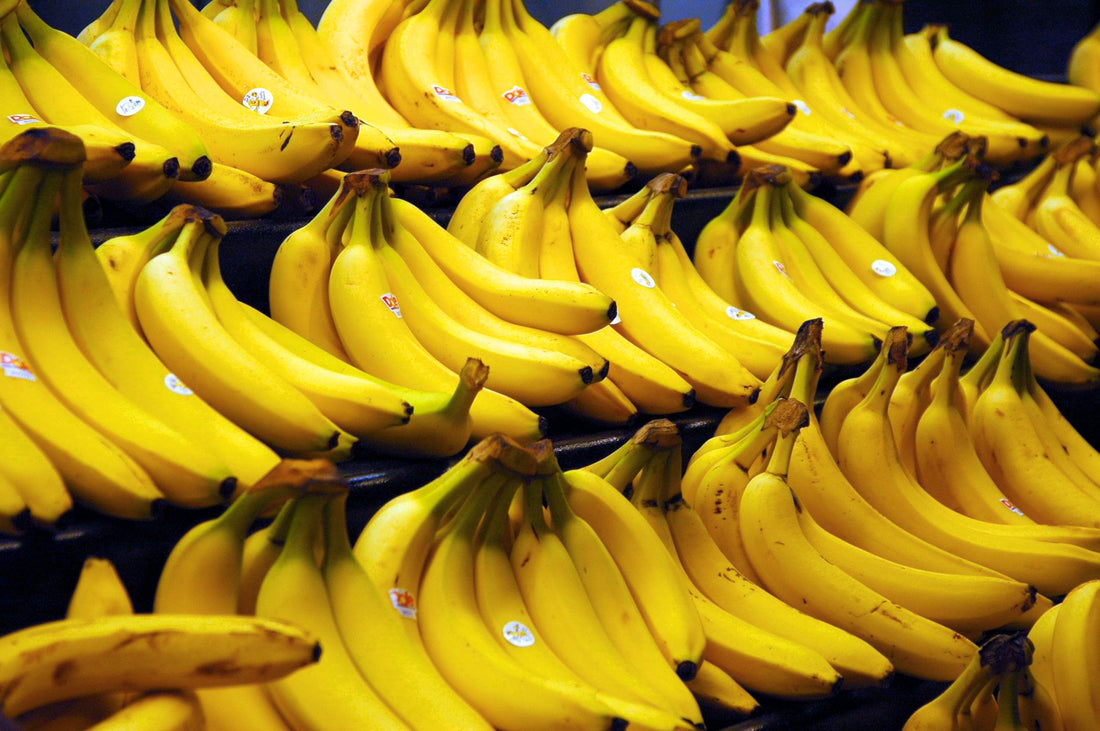There have been many a February Saturday when our BrightSide delivery team has scrambled over a snowbank with a 40-lb case of bananas headed to one of our partner corner stores. And it has always seemed a bit strange. How can an item be so popular in the US even though it can only be grown thousands of miles away in lush tropical regions and is easily damaged during transport?
But popular it is. We consistently sell about 500 lbs of conventionally grown bananas each week to corner stores in Minneapolis. It is by far our top selling item to corner stores.

And in some ways that isn’t surprising. Conventional bananas are relatively cheap, easy to eat, and, for most people, tasty. They are by far the most eaten fresh fruit in the US. In 2020, the USDA estimated that banana consumption per capita in the US was 13.4 lbs per year (loss adjusted, that’s about 60 bananas per person, or 1 banana every 6 days). For comparison, Americans eat about 9.5 lbs of apples per person per year.
So, if bananas are inexpensive and tasty, what’s not to like? Actually, quite a bit.
Environmental costs of bananas
There are three main environmental issues associated with banana production: pesticide use, transportation costs, and tropical deforestation.
Pesticide use. Banana plantations are particularly susceptible to pest infection and substantial amounts of chemicals are used to control those pests. In Costa Rica, most bananas for export are grown in large monocultures. Moreover, genetic variation in these bananas is essentially zero, meaning that pests can rapidly evolve to overcome any kind of natural defense that the banana plants have. In response, there is intensive agrochemical use. A 2016 estimate suggested that ~76 kg of chemical control is applied per hectare each year (Echeverría-Sáenz et al., 2016) to control nematodes, insects, and weeds. Although evidence suggests that little of this chemical ultimately gets into consumers, other evidence indicates that it affects farm workers and the ecosystems around plantations. Amazingly, given the huge number of bananas that are grown, there still isn’t much information available about the local impacts of chemical use on banana plantations.
Transportation costs. If you ever work with wholesale bananas, you’ll notice that they are meticulously cared for. They are packed in boxes with almost exactly 40lbs of fruit. Bananas are laid out in four neatly arranged rows of small banana bunches (technically called a “hand”), and each hand has about 4-6 bananas. The rows of bananas are carefully separated by thin plastic to increase ventilation. Without adequate ventilation, ethylene gas emitted from the bananas builds up in the box and makes them ripen too quickly. Box corners are reinforced to prevent compression, making them easy to stack. Finally, the bananas are stored at precisely 55̊°F throughout the transportation process. If the temperature is warmer than that, they ripen too quickly and become mottled. If the temperature is colder than that, they get brown before they ripen. Most other fruits are stored at room temperature or the more typical 35-40°F refrigeration temperature.
In addition to all of their particular care needs, bananas also have to be transported long distances from where they are grown (tropical areas like Costa Rica) to reach markets in North American and Europe. A recent study found that transportation costs for bananas were significant, despite the fact that most of the transport was done by cargo ships (which is usually a pretty low impact way of transporting items).

Tropical deforestation and biodiversity. The main reason distributing bananas makes us cringe a bit is because of the impact of banana production on tropical forests and terrestrial biodiversity. Bananas need to be grown in hot, humid, rainy, and flat landscapes. Before human incursion, these areas supported some of the most biodiverse ecosystems on the planet.
The impact of banana plantations on biodiversity loss is rarely quantified because the land for plantations was often cleared decades ago, so the direct impact on biodiversity was in the past. However, one could still calculate how much biodiversity could be supported if banana plantations were removed and biodiversity was restored. We haven’t found a study yet that makes those calculations.
There are also significant social costs associated with banana production. These are described in some detail in this blog post from a few years ago.
To eat or not to eat bananas
Alas, the situation is complicated. Bananas are a major export crop for places like Costa Rica and banana operations support many jobs. The low price of bananas helps people throughout the US, including at corner stores in Minneapolis, buy affordable and healthy snacks. And bananas are yummy! Many BrightSide employees eat bananas on a regular basis.
It is possible to grow bananas without clear cutting forests and using a lot of chemicals. But such bananas are more expensive, making it harder to stock at corner stores (owners of our partner corner stores have told us that they are not interested in organic produce because their customers generally can’t afford the higher prices).
In the end, we just try to do what we can. We work hard to avoid wasting any bananas, and we try to think big about how to make major changes in the food system. If more money is available for consumers, maybe more people will buy more eco-friendly bananas that can feed people without destroying primary rainforest. Fair trade bananas are available and we often include them in our organic bundles (more information about fair trade bananas is here: http://www.fairtrade.net/bananas.html)

